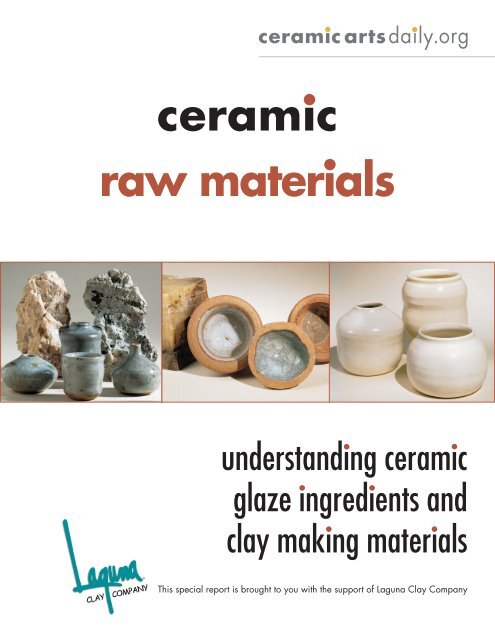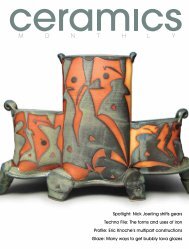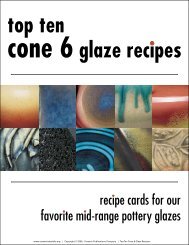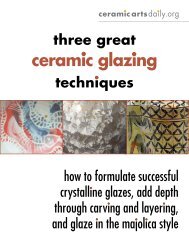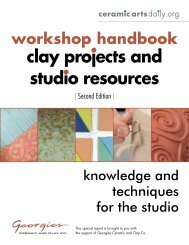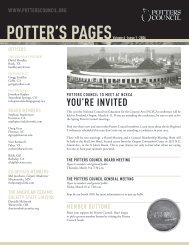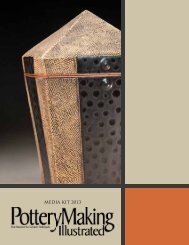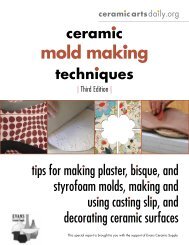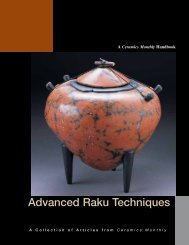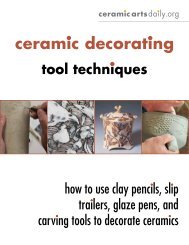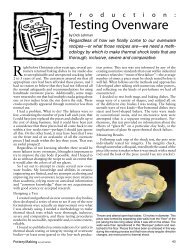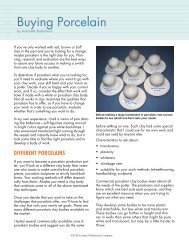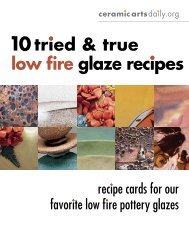ceramic raw materials - Ceramic Arts Daily
ceramic raw materials - Ceramic Arts Daily
ceramic raw materials - Ceramic Arts Daily
You also want an ePaper? Increase the reach of your titles
YUMPU automatically turns print PDFs into web optimized ePapers that Google loves.
<strong>ceramic</strong><br />
<strong>ceramic</strong> artsdaily.org<br />
<strong>raw</strong> <strong>materials</strong><br />
understanding <strong>ceramic</strong><br />
glaze ingredients and<br />
clay making <strong>materials</strong><br />
This special report is brought to you with the support of Laguna Clay Company<br />
www.<strong>ceramic</strong>artsdaily.org | Copyright © 2010, <strong>Ceramic</strong> Publications Company | <strong>Ceramic</strong> Raw Materials | i
<strong>Ceramic</strong> Raw Materials<br />
Understanding <strong>Ceramic</strong> Glaze Ingredients<br />
and Clay Making Materials<br />
Today, we live in an age of super abundance of <strong>ceramic</strong> <strong>raw</strong> <strong>materials</strong>. Innumerable clays and glaze <strong>materials</strong> offer us a<br />
bewildering array of choices. Far from understanding these <strong>materials</strong> as familiar rocks, feldspars, and clays, each with<br />
unique personalities of their own, we know them only as white, gray, or brown powders neatly packaged in uniform bags.<br />
Consequently we beg, borrow, and steal glaze and clay body recipes that “work.”<br />
<strong>Ceramic</strong> <strong>raw</strong> <strong>materials</strong> come to us from every corner of the earth in a purified and refined state. We no longer live at the<br />
source of our <strong>ceramic</strong> <strong>materials</strong> as did the potters of ancient times. It now becomes a Herculean feat to know or understand<br />
in any meaningful way the flood of <strong>ceramic</strong> <strong>materials</strong> at our disposal. Fortunately, it is not necessary to have an<br />
intimate understanding of these hundreds of <strong>ceramic</strong> <strong>materials</strong>. Ancient potters created their masterpieces from three or<br />
four <strong>ceramic</strong> <strong>materials</strong>, and, if we similarly narrow our choices, we can also achieve extraordinary results. <strong>Ceramic</strong> Raw<br />
Materials: Understanding <strong>Ceramic</strong> Glaze Ingredients and Clay Making Materials offers access to that knowledge,<br />
including how to formulate a glaze using a glaze core, charts for clays and feldspars found in most clay and glaze recipes,<br />
a glossary of common <strong>ceramic</strong> <strong>raw</strong> <strong>materials</strong>, and the primary functions of those <strong>materials</strong>.<br />
Understanding Glazes Through Raw Materials:<br />
Using Glaze Cores<br />
By Mimi Obstler<br />
There are so many <strong>materials</strong> available to <strong>ceramic</strong> artists that it can be somewhat overwhelming. But if you<br />
understand the concept and function behind glaze cores, the process becomes far more manageable.<br />
Glossary of Common <strong>Ceramic</strong> Raw Materials<br />
This quick reference to the most common North American <strong>raw</strong> <strong>materials</strong> will come in handy when formulating<br />
clay bodies as well as glazes.<br />
Primary Functions of Common <strong>Ceramic</strong> Raw Materials<br />
A companion to the glossary of common <strong>materials</strong> used in studio <strong>ceramic</strong>s, this chart allows quick identification<br />
and understanding of the main uses of our <strong>materials</strong>.<br />
Clay Materials We Use<br />
Because clays and recipes can change over time, it is good to know specifically what your clay contains. If you<br />
need to substitute one material for another, you’ll want to get as close as possible, so you’re changing as little as<br />
you can.<br />
Feldspars Used in <strong>Ceramic</strong> Glazes and Clay Making<br />
These handy <strong>materials</strong>, used as the core of glazes as well as in most clay bodies, appear in lots of recipes. Some<br />
of the recipes may be so old half of the <strong>materials</strong> listed are no longer available or their names have been changed.<br />
If this happens to you, this guide will help you identify the best possible substitute.<br />
www.<strong>ceramic</strong>artsdaily.org | Copyright © 2010, <strong>Ceramic</strong> Publications Company | <strong>Ceramic</strong> Raw Materials | 1
Understanding Glazes<br />
Through Raw Materials:<br />
Using Glaze Cores<br />
An analysis of certain<br />
beautiful Song Dynasty<br />
porcelain glazes revealed<br />
that a single feldspathic<br />
rock material (Petuntse) provided<br />
the core of the glaze. This single<br />
material contained nearly the right<br />
proportion of glassmaker, adhesive,<br />
and melter oxides. Only small<br />
amounts of wood ash and limestone<br />
<strong>materials</strong> were added to improve the<br />
color and melt of the glaze. I believe<br />
that this is still the most meaningful<br />
way to approach the stoneware<br />
glaze, or any glaze or clay body for<br />
that matter. The objective is to locate<br />
one single earth material that<br />
alone almost provides the desired<br />
surface, and then to add as few additional<br />
<strong>materials</strong> as possible. I call<br />
this primary material, which almost<br />
achieves the desired glaze surface, a<br />
“glaze core.” The list of glaze cores<br />
is long and disparate and includes<br />
feldspars, mica, granitic rocks,<br />
some clays, volcanic ash, wood ash,<br />
boron minerals, and the artificial<br />
manufactured frits. The key characteristic<br />
of these <strong>materials</strong> is their<br />
combination of glassmaker, adhesive,<br />
and melter functions.<br />
Feldspars and feldspathic rocks<br />
contain a complex structure of<br />
silica, alumina, and the melter<br />
oxides of sodium, potassium, and<br />
calcium. This structure makes<br />
them ideal glaze cores at stoneware<br />
temperatures.<br />
Mix powdered feldspar with<br />
water, apply this mixture to a clay<br />
By Mimi Obstler<br />
Feldspars and Rocks: Stoneware test pots by Barbara Beck, fired to cone 9–10<br />
reduction. Glaze: Feldspar 90%, Whiting 10%, Red iron oxide, ½%. Pots, left to<br />
right: Potash feldspar, Cornwall Stone, Soda feldspar. Pot, rear, center: Nepheline<br />
Syenite. Rocks, left to right: Soda feldspar, Potash feldspar, Nepheline Syenite,<br />
Cornwall Stone.<br />
form, fire it to stoneware temperatures,<br />
and there will appear a<br />
glossy, white surface on the clay.<br />
Thus, feldspars and feldspathic<br />
rocks with their complex chemical<br />
structure of silica, alumina, and<br />
melter oxides of sodium, potassium,<br />
and calcium possess the unique<br />
ability to form an “almost” acceptable<br />
glaze surface at stoneware<br />
firing temperatures.<br />
Origin<br />
Throughout earth’s history, violent<br />
upheavals have forced silica-rich<br />
magma up toward the earth’s outer<br />
layers. Under these outer layers, the<br />
magma cooled slowly for thousands<br />
of years to form the largegrained<br />
crystalline rocks known<br />
as granite. When exposed on the<br />
earth’s surface, granites are subjected<br />
to two types of weathering.<br />
Mechanical weathering (physical<br />
disintegration of granites by expansion<br />
of water, tree roots, groundwater,<br />
animal footsteps, etc.)<br />
causes the granites to be broken<br />
down into their various minerals—<br />
mainly feldspars, quartz, and micas.<br />
Chemical weathering (chemical<br />
reaction of the granites to the air,<br />
www.<strong>ceramic</strong>artsdaily.org | Copyright © 2010, <strong>Ceramic</strong> Publications Company | <strong>Ceramic</strong> Raw Materials | 2
living beings, earth, and water on<br />
the earth’s surface and atmosphere)<br />
causes some feldspar and mica<br />
minerals to further decompose into<br />
clay minerals.<br />
Granites are the basis of most of<br />
our <strong>ceramic</strong> <strong>materials</strong> and make<br />
up 75% of the earth’s crust. They<br />
are rocks, which by definition are<br />
mixtures of one or more minerals.<br />
Granites consist of over 50%<br />
potash and soda feldspar and up<br />
to 25% quartz. They also contain<br />
as much as 20% mica and lesser<br />
amounts of magnesium-iron minerals.<br />
Some granites, if crushed to a<br />
fine particle size, will make exciting<br />
glaze surfaces at high stoneware<br />
temperatures.<br />
General<br />
Characteristics<br />
of Feldspars<br />
Feldspar includes an assortment of<br />
minerals of varying composition.<br />
Despite this range, the feldspars commonly<br />
used by potters tend to follow<br />
a fairly recognizable pattern when<br />
fired to stoneware temperatures.<br />
1. The most striking characteristic<br />
of a feldspar that is fired to<br />
stoneware temperatures is the formation<br />
of a glassy, white surface.<br />
The heat of the stoneware kiln<br />
fire, combined with the feldspar’s<br />
soda and potash melter oxides<br />
(14%–15%) have transformed its<br />
considerable silica content (60%–<br />
70%) into glass. The white color is<br />
a happy consequence of the selection<br />
of atoms by size—the atoms of<br />
the coloring minerals such as iron<br />
and copper are too large to fit into<br />
the feldspathic structure. The result<br />
is a relatively pure white material<br />
to which colorants can always be<br />
added.<br />
2. The melting action of the feldspars<br />
has a very long range: 2138°F<br />
(cone 4) to 2381°F (well beyond<br />
cone 10).<br />
3. Melted feldspars possess a<br />
high surface tension because of<br />
their considerable alumina content<br />
Rock: Calcite: Calcium Carbonate (Collection of Department of Earth and<br />
Environmental Sciences, Columbia University, New York).<br />
Tests: Feldspar and Whiting (Calcium Carbonate) on stoneware fired to<br />
cone 9–10 reduction.<br />
Left: Potash feldspar 100%.<br />
Center: Potash feldspar 90%, Whiting 10%.<br />
Right: Whiting (Calcium Carbonate) 100%.<br />
Left: Granite. Slow-cooled, coarse-grained, igneous rock containing 25%<br />
quartz, 50% feldspar (mostly potash in this sample), some muscovite,<br />
biotite, and/or amphibole.<br />
Right: Rhyolite. Fast-cooled, fine-grained igneous rock with the same<br />
chemical composition as granite.<br />
(Collection of Department of Earth and Environmental Sciences, Columbia<br />
University, New York).<br />
(17%–25%); they c<strong>raw</strong>l and flow<br />
unevenly. This is especially noticeable<br />
with a thick coat of feldspar.<br />
4. The surface of melted feldspars<br />
contains an intricate network of<br />
fine cracks alternately described<br />
as “crazes” if considered a glaze<br />
defect and “crackle” if considered<br />
aesthetically desirable. Melting oxides,<br />
contained in the oxide structure<br />
of the feldspar, are responsible<br />
for the craze/crackle network.<br />
These melting oxides are for the<br />
most part sodium and potassium,<br />
which undergo a high rate of expansion<br />
when heat converts them<br />
from a solid into a liquid state.<br />
5. Feldspars do not remain<br />
evenly suspended in the liquid glaze<br />
mixture. The feldspathic powder<br />
settles at the bottom of the glaze<br />
bucket, forming a dense, rock-like<br />
substance that defies even the most<br />
vigorous attempts at disbursement.<br />
It must now be apparent that<br />
although feldspar provides the<br />
basic core of a stoneware glaze,<br />
it does present certain problems<br />
for the potter. We can solve these<br />
problems by adding small quantities<br />
of three or four minerals to the<br />
feldspathic glaze.<br />
Additions of limestone or calcium<br />
minerals will increase the<br />
www.<strong>ceramic</strong>artsdaily.org | Copyright © 2010, <strong>Ceramic</strong> Publications Company | <strong>Ceramic</strong> Raw Materials | 3
Cone 5–6 oxidation. Porcelain claybody. Left: Satin-matt surface: Nepheline Syenite 80%,<br />
Wollastonite 20%. Back: Gloss surface: Jacky’s Clear: Nepheline Syenite, 50; Colemanite, 10;<br />
Wollastonite, 10; Flint, 20; Zinc oxide, 5; Ball Clay, 5; Bentonite, 2. Front: Matt surface: Ron’s<br />
White Matt #5: F-4 Feldspar, 55; Whiting, 15; EPK, 16; Zinc oxide, 14.<br />
melt at stoneware temperatures<br />
and thus quicken the flow of the<br />
feldspathic glaze.<br />
Additions of the glassmaker (silica)<br />
will eliminate the craze/crackle<br />
network, should this be desired.<br />
Silica, unlike the sodium and potassium<br />
melters, has a minimal rate of<br />
contraction upon cooling, and thus<br />
inhibits the high contraction rate of<br />
these melters.<br />
Physical suspension of the<br />
feldspar in the liquid glaze may be<br />
improved by adding 10% or more<br />
of clay <strong>materials</strong> such as kaolin or<br />
ball clays. The addition of the clay<br />
<strong>materials</strong> will also toughen the <strong>raw</strong><br />
glaze coat and help it withstand the<br />
handling that takes place when the<br />
kiln is stacked. Suspension will be<br />
further improved by the addition of<br />
2%– 3% superplastic clay (bentonite)<br />
or even smaller amounts of<br />
soda ash or Epsom salts (magnesium<br />
sulfate).<br />
Minerals, such as copper, iron, or<br />
cobalt, may be added in oxide or<br />
carbonate form to achieve color.<br />
This combination of <strong>materials</strong><br />
spawns a broad range of standard<br />
stoneware glazes. Although a specific<br />
stoneware glaze formula may<br />
show four or even five ingredients<br />
in its recipe, in most cases the core<br />
of the glaze is the feldspar. The rest<br />
of the <strong>materials</strong> are present in order<br />
to cure the problems contained in<br />
the feldspar.<br />
At the cone 5/6 oxidation temperatures,<br />
70% F-4 feldspar and<br />
30% Wollastonite creates a creamy,<br />
satin-matt surface. See also the example<br />
piece with Nepheline Syenite<br />
80%, Wollastonite 20% above.<br />
The oxide structure of a feldspar<br />
explains why it constitutes the central<br />
ingredient core of a stoneware<br />
glaze. Most feldspars contain about<br />
60%–70% silica (the glassmaker),<br />
17%–25% alumina (the adhesive),<br />
and 10%–15% sodium, potassium,<br />
and/or calcium oxide (the melters).<br />
This text was excerpted from Out of<br />
the Earth, Into the Fire: A Course in<br />
<strong>Ceramic</strong> Materials for the Studio Potter,<br />
by Mimi Obstler. Available at<br />
www.<strong>ceramic</strong>artsdaily.org/bookstore.<br />
www.<strong>ceramic</strong>artsdaily.org | Copyright © 2010, <strong>Ceramic</strong> Publications Company | <strong>Ceramic</strong> Raw Materials | 4
Glossary of Common<br />
<strong>Ceramic</strong> Raw Materials<br />
barium carbonate BaCO 3 —alkaline earth—active high temperature<br />
flux, but also promotes matt glaze surface. Unsafe for low-fire functional<br />
glazes. Often used as an additive in clay bodies in very small<br />
percentages to render sulfates insoluble, reducing scumming.<br />
bentonite Al 2 O 3 •5SiO 2 •7H 2 O—formed from decomposition of airborne<br />
volcanic ash. Suspension agent used in quantities no more than<br />
3% of dry <strong>materials</strong> weight.<br />
bone ash (calcium phosphate) Ca 3 (PO 4 ) 2 —high temperature flux—<br />
opacifier in low temperature glazes—translucence in high temperature<br />
glazes.<br />
borax (sodium tetraborate) Na 2 O•2B 2 O 3 •10H 2 O—a major low<br />
temperature alkaline flux, available in granular or powdered form.<br />
Gives smooth finish, bright colors. Water soluble, so often used in<br />
fritted form.<br />
chrome oxide Cr 2 O 3 —standard vivid green colorant—often softened<br />
with a little iron or manganese. Very refractory. With tin produces<br />
pink.<br />
cobalt carbonate CoCO 3 —standard blue colorant for slips and<br />
glazes—5% will give dark blue in glaze or slip. Will cause c<strong>raw</strong>ling if<br />
used <strong>raw</strong> for underglaze brushwork.<br />
copper carbonate CuCO 3 —a major glaze colorant to produce greens in<br />
low temperature and high temperature, copper reds in high temperature<br />
reduction, and greens and metallic effects in raku.<br />
dolomite MgCO 3 •CaCO 3 —high temperature alkaline earth flux, promotes<br />
hard, durable surfaces and recrystallization/matting in glazes.<br />
feldspar High temperature alkaline fluxes—insoluble aluminum silicates<br />
of potassium, sodium, calcium, and/or lithium—inexpensive<br />
flux for glaze.<br />
frit Fluxes that have been melted to a glass, cooled, and ground in order<br />
to stabilize soluble and/or toxic components during handling of unfired<br />
material.<br />
ilmenite An iron ore with significant titanium—most often used in<br />
granular form to produce dark specks in clay or glaze. Higher iron<br />
concentration than in rutile.<br />
iron oxide, red (ferric oxide) Fe 2 O 3 —refractory red in oxidation, converts<br />
to black iron (flux) in reduction and/or high-fire. Low quantities<br />
in clear glaze produces celadon green—high quantities produce temmoku<br />
black or saturated iron red—powerful flux.<br />
kaolin; china clay Al 2 O 3 •2SiO 2 •2H 2 O—very refractory white primary<br />
clay. Source of alumina in glazes.<br />
lithium carbonate Li 2 CO 3 —powerful all temperature alkaline flux, especially<br />
with soda or potash feldspars. Promotes hardness and recrystallization<br />
in low temperature glazes.<br />
magnesium carbonate MgCO 3 —alkaline earth—high temperature<br />
flux, promotes mattness and opacity in low temperature glazes,<br />
smooth, hard, buttery surface in high temperature glazes—promotes<br />
purples/pinks with cobalt. Used to promote controlled c<strong>raw</strong>l<br />
glaze effects.<br />
manganese dioxide MnO 2 —flexible colorant—with alkaline fluxes<br />
gives purple and red colors—by itself gives soft yellow-brown—<br />
with cobalt gives black. Used with iron to color basalt bodies. Concentrations<br />
of more than 5% may promote blistering.<br />
nepheline syenite K 2 O•3Na 2 O•4Al 2 O 3 •9SiO 2 —a common feldspathic<br />
flux, high in both soda and potash. Less silica than soda feldspars,<br />
and therefore more powerful. Increases firing range of low-fire and<br />
mid-range glazes.<br />
rutile Source of titanium dioxide, contains iron, other trace minerals—<br />
gives tan color, promotes crystallization giving mottled multi color<br />
effects in some high temperature glazes, or in overglaze stain.<br />
silica (silicon dioxide, flint, quartz) SiO 2 —main glass-former—vitrification,<br />
fluidity, transparency/opacity controlled by adding fluxes<br />
and/or refractories.<br />
spodumene Li 2 O•Al 2 O 3 •4SiO 2 —lithium feldspar—powerful high<br />
temp alkaline flux, promotes copper blues, good for thermal-shock<br />
bodies and matching glazes.<br />
strontium carbonate SrCO 3 —alkaline earth, high temperature flux,<br />
similar to barium, slightly more powerful—gives semi-matt surfaces.<br />
Nontoxic in balanced glaze.<br />
talc 3MgO•4SiO 2 •H 2 O—high temperature alkaline earth flux in glaze,<br />
promotes smooth buttery surfaces, partial opacity—similar composition<br />
to clay.<br />
tin oxide SnO 2 —most powerful opacifier, but expensive—inert dispersoid<br />
in glaze melt—5–7% produces opaque white in a clear glaze.<br />
titanium dioxide TiO 2 —matting/opacifying agent. Promotes crystal<br />
growth, visual texture in glazes.<br />
whiting (calcium carbonate, limestone) CaCO 3 —alkaline earth, contributing<br />
calcium oxide to glaze—powerful all temperature flux—<br />
major high temperature flux for glazes—gives strong durable glass.<br />
wollastonite (calcium silicate) CaSiO 3 —In some cases, it is used in<br />
place of whiting.<br />
zinc oxide ZnO—high temperature flux that promotes brilliant glossy<br />
surfaces. Can encourage opacity, with titanium in low-alumina glaze<br />
can encourage macrocrystalline growth.<br />
zirconium silicate ZrSiO 4 —zircon opacifier—low-cost substitute for<br />
tin oxide—use double the recipe weight of tin. Includes Zircopax,<br />
Opax, Superpax, Ultrox.<br />
Excerpted from Clay: A Studio Handbook by Vince Pitelka.<br />
www.<strong>ceramic</strong>artsdaily.org | Copyright © 2010, <strong>Ceramic</strong> Publications Company | <strong>Ceramic</strong> Raw Materials | 5
Primary Function of Common<br />
<strong>Ceramic</strong> Raw Materials<br />
Material Glaze Function Substitute Comment<br />
Barium Carbonate Flux Strontium carbonate<br />
Bentonite Suspension agent Ball Clay Do not exceed 3%<br />
Bone Ash Opacifier<br />
Borax Flux, glassmaker Boron frits<br />
Chrome Oxide Colorant Green<br />
Cobalt Carbonate Colorant Cobalt oxide Blue<br />
Copper Carbonate Colorant Copper oxide Greens, copper reds<br />
Cornwall Stone Flux, opacifier<br />
Custer Feldspar Glaze core Potash feldspar (G-200)<br />
Dolomite Flux, opacifier Whiting Many brands<br />
EPK Kaolin Alumina, opacity Kaolin<br />
Ferro Frit 3110 Glaze core, flux Pemco P-IV05, Fusion F-75 Crystalline glazes<br />
Ferro Frit 3124 Glaze core, flux F-19, P-311, Hommel 90 Boron frit<br />
Ferro Frit 3134 Glaze core, flux F-12, P-54, Hommel 14 Boron frit<br />
Ferro Frit 3195 Glaze core, flux Hommel 90, Fusion F-2 Complete glaze<br />
Ferro Frit 3269 Flux, glaze core Pemco P-25<br />
Ferro Frit 3278 Flux, glaze core Fusion F-60, Pemco P-830<br />
G-200 Feldspar Glaze core Potash feldspar (Custer)<br />
Green Nickel Oxide Colorant Black nickel oxide Blues, tan, browns, greens, grays<br />
Kentucky OM4 Ball Clay Alumina, opacity Ball Clay<br />
Kona F-4 Feldspar Glaze core Soda feldspar<br />
Lithium Carbonate Flux<br />
Magnesium Carbonate Flux, opacifier Promotes c<strong>raw</strong>ling<br />
Manganese Dioxide Colorant Purple, red, yellow-brown<br />
Nepheline Syenite Glaze core<br />
Red Iron Oxide Colorant Celadon green to brown<br />
Rutile Colorant Ilmenite<br />
Silica Glass former, glaze fit Flint Use 325 mesh<br />
Spodumene Lithium glaze core<br />
Strontium Carbonate Flux Barium carbonate<br />
Talc Flux, opacifier Many brands<br />
Tin Oxide Opacifier Zircopax<br />
Titanium Dioxide Opacifier<br />
Whiting Flux, opacifier Wollastonite, Dolomite Many brands<br />
Wollastonite Flux, opacifier Whiting, dolomite<br />
Wood Ash Glaze core, flux, colorant Whiting Results vary by type<br />
Zinc Oxide Flux, opacifier<br />
Zircopax Opacifier Superpax, Ultrox<br />
Notes:<br />
1. Substituting glaze ingredients may alter color, texture, opacity, viscosity, and/or sheen, as well as create pinholing, crazing, black<br />
spotting, and/or pitting. In most cases, additional adjustments to other ingredients need to occur when substituting.<br />
2. Test and record your results.<br />
3. Materials vary from supplier to supplier and batch to batch.<br />
www.<strong>ceramic</strong>artsdaily.org | Copyright © 2010, <strong>Ceramic</strong> Publications Company | <strong>Ceramic</strong> Raw Materials | 6
Clay Materials We Use<br />
There are probably as many kinds of clay as there<br />
are riverbanks, creekbeds, roadcuts, abandoned<br />
coal mines and backyard gullies, but most of the<br />
clays that many of us use on a regular basis are<br />
commercially mined.<br />
Because not all <strong>materials</strong> are available through all suppliers,<br />
this chart is meant to provide data for the most<br />
common clays used in recipes you are likely to come<br />
across. You can use these data to compare the <strong>materials</strong><br />
available through your supplier, or those you have on<br />
hand, with <strong>materials</strong> in the published recipes.<br />
While the satisfaction, discovery and personal control<br />
that is possible through prospecting and processing your<br />
own clay are certainly valid reasons for the effort, most of<br />
us rely on the consistency and (relative) reliability of airfloated<br />
<strong>materials</strong> mined in large quantities. Even though<br />
the reasons for using commercially mined clays are most<br />
often based on a desire for a trouble-free product, the<br />
properties of clay as a natural material can make this goal<br />
somewhat elusive. The following chart contains the most<br />
recent information available.<br />
However, because the chemical and physical makeup<br />
of naturally mined <strong>materials</strong> can change across a given<br />
deposit, this chart is meant to be used as a starting point<br />
for clay substitutions. In order to precisely recalculate a<br />
recipe using a substituted clay, you will need to obtain<br />
a current data sheet for all <strong>materials</strong> you purchase from<br />
your supplier.<br />
Please note that the clays are presented in alphabetical<br />
order, and the formulae are presented with alumina<br />
(Al 2 O 3 ) in unity (totalling 1). This makes it easier to immediately<br />
see the ratio of alumina to silica, and also more<br />
accurately compares the relative amounts of all other<br />
components in the clays.<br />
Clay Name Al:Si M.Wt. BaO CaO MgO K2O Na 2 O TiO MnO Al 2 O 3 Fe 2 O 3 P 2 O5 SiO 2<br />
54-S Ball Clay 1:3.28 314.3 .009 .027 .039 .006 .074 1 .023 3.28<br />
6 Tile Clay 1:2.03 267.72 .019 .033 .002 .047 1 .005 2.03<br />
A.P. Green Fireclay 1:2.85 327.92 .021 .029 .017 .027 .083 1 .041 2.85<br />
Albany Slip Clay 1:4.44 462.93 .479 .304 .157 .06 .046 .004 1 .15 4.44<br />
Alberta Slip 1:7.66 742.12 .785 .574 .230 .229 1 .219 7.66<br />
Avery Kaolin 1:2.12 234.35 .026 .007 .002 1 .013 2.12<br />
Barnard Clay 1:10.51 1343 .136 .227 .162 .123 .038 1 2.845 10.5<br />
Bell Dark Ball Clay 1:3.58 368.23 .02 .018 .016 .006 .069 1 .023 3.58<br />
Blackbird Clay 1:9.3 937.53 .045 .174 .204 .018 .079 .367 1 .860 9.33<br />
C&C Ball Clay 1:3.51 327.16 .007 .018 .028 .012 .074 1 .023 3.51<br />
Carbondale Red Clay 1:4.97 531.21 .005 .053 .085 .029 .051 .069 .002 1 .4 .003 4.97<br />
Cedar Heights Bonding Clay 1:3.16 311.57 .012 .026 .063 .011 .069 1 .037 3.16<br />
Cedar Heights Goldart 1:3.53 373.17 .015 .039 .074 .01 .082 1 .033 3.53<br />
Cedar Heights Redart 1:7.11 626.27 .05 .26 .29 .04 .09 1 .29 .01 7.11<br />
Edgar Plastic Kaolin 1:2.09 272.29 .006 .008 .012 .002 .01 1 .012 .002 2.09<br />
Fremington Clay 1:5.04 507.14 .441 .5 .214 .036 .06 1 .19 5.04<br />
Grolleg Kaolin 1:2.2 271.38 .005 .021 .009 .004 .001 1 .012 2.21<br />
Hawthorn Bond Fireclay 1:2.51 268.80 .017 .023 .026 .005 .070 1 .033 .004 2.51<br />
www.<strong>ceramic</strong>artsdaily.org | Copyright © 2010, <strong>Ceramic</strong> Publications Company | <strong>Ceramic</strong> Raw Materials | 7<br />
Continued
Clay Name Al:Si M.Wt. BaO CaO MgO K2O Na 2 O TiO MnO Al 2 O 3 Fe 2 O 3 P 2 O5 SiO 2<br />
Helmer Kaolin 1:2.22 283.33 .024 .018 .016 .004 .040 1 .023 2.22<br />
Hymod A1 1:3.05 306.76 .012 .034 .101 .022 .043 1 .030 3.06<br />
Hyplas 71 1:5.86 481.54 .009 .051 .103 .033 .109 1 .029 5.86<br />
Jordan Fireclay 1:5.64 500.69 .014 .065 .033 .05 .075 1 .063 5.64<br />
Kaopaque 20 Kaolin 1:1.56 253.14 .01 .002 .002 .001 .021 1 .005 1.96<br />
Kentucky Special Clay 1:3 354.88 .023 .031 .035 .01 .066 1 .019 2.98<br />
Kentucky Stone 1:5.51 492.75 .035 .037 .068 .016 .068 1 .043 5.51<br />
KTS-2 Ball Clay 1:4.28 419.75 .022 .042 .058 .014 .074 1 .026 4.28<br />
Lincoln 60 Fireclay 1:3.76 372.15 .006 .089 .022 .036 1 .05 3.76<br />
Lizella Clay 1:4.8 488.93 .048 .098 .068 .048 .068 1 .154 4.82<br />
New Foundry Hill Creme Clay 1:3.94 353.89 .014 .030 .030 .013 .070 1 .025 3.94<br />
Ocmulgee Red Clay 1:4.2 401.5 .048 .034 .064 .027 .07 1 .187 4.2<br />
OM #4 Ball Clay 1:3.36 365.59 .020 .036 .039 .018 .055 1 .025 3.36<br />
PBX Fireclay 1:2.49 262.47 .017 .023 .05 1 .029 2.5<br />
PBX Valentine Clay 1:2.5 278.74 .001 .019 .004 .002 .07 1 .125 2.49<br />
Pine Lake Fireclay 1:3.64 338.13 .02 .009 .02 .018 .089 1 .035 3.64<br />
Pioneer Kaolin 1:2.02 265.03 .009 .007 .003 .002 .047 1 .007 2.02<br />
Plainsman Fireclay 1:3.49 332.19 .013 .009 .081 .059 .032 1 .034 3.49<br />
Plastic Vitrox 1:8.64 686.51 .027 .034 .496 .032 1 .004 8.64<br />
Ravenscrag Slip 1:8.28 686.42 .639 .339 .257 .058 .039 1 .04 8.28<br />
Redstone 1:8.93 736.21 .028 .138 .202 .001 .06 1 .191 8.93<br />
Remblend Kaolin 1:8.28 686.42 .639 .339 .257 .058 .039 1 .039 8.28<br />
Sagger XX Ball Clay 1:3.3 349.68 .031 .026 .033 .017 .075 1 .015 3.30<br />
Taylor 1:4.17 367.29 .003 .021 .022 .007 .092 1 .023 4.17<br />
Tennessee #10 Ball Clay 1:2.67 309.89 .005 .015 .036 .01 .07 1 .015 2.67<br />
Thomas Clay 1:3.8 443.58 .004 .019 .016 .005 .077 1 .025 3.81<br />
TN#1-SGP Ball Clay 1:3.52 365.59 .013 .027 .047 .012 .069 1 .018 3.52<br />
Troy Clay 1:2.51 261.54 .011 .015 .005 .046 1 .021 2.51<br />
Velvacast Kaolin 1:2.01 265.76 .003 .011 .008 .004 .044 1 .004 2.01<br />
Yellowbanks #401 1:3 294.24 .022 .079 0 .002 .034 1 .030 3<br />
www.<strong>ceramic</strong>artsdaily.org | Copyright © 2010, <strong>Ceramic</strong> Publications Company | <strong>Ceramic</strong> Raw Materials | 8
Feldspars Used in<br />
<strong>Ceramic</strong> Glazes<br />
and Clay Making<br />
Feldspars are important ingredients in clay bodies<br />
and glazes. In both applications, their primary<br />
function is to supply fluxes to the formulations,<br />
but they also provide additional alumina (Al2O3)<br />
and silica (SiO2). Feldspars are naturally occurring minerals<br />
and are generally classified as either potash (potassium)<br />
or soda (sodium) feldspars based upon the predominant<br />
alkali metal element (the flux) that is present. The minerals<br />
commonly referred to as lithium feldspars are not true<br />
feldspars, but they are aluminosilicates like feldspars and<br />
contain the fluxing element lithium, and are used for the<br />
same purposes as the feldspars.<br />
The following table presents typical chemical analyses<br />
(in weight percent) provided by the suppliers, for a<br />
number of common feldspar products and related <strong>materials</strong>.<br />
Most of the names are trade names, with the exceptions<br />
of lepidolite, petalite, and spodumene, which are<br />
true mineral names. Nepheline syenite is actually a rock<br />
composed of potash and soda feldspars plus the mineral<br />
nepheline (a sodium aluminum silicate). In the table, the<br />
trade names for the feldspars are grouped according to<br />
the actual type of feldspar that they contain. Distinguishing<br />
between the different types of feldspars based upon<br />
the fluxes that they provide is important because of the<br />
different characteristics that each of the fluxes contributes<br />
to a wide variety of properties such as melting point,<br />
thermal expansion, glaze color and hardness. For each<br />
analysis, the remaining percentage needed to bring the<br />
total of all the elements to 100% is the ignition loss (not<br />
shown in the table).<br />
The analyses will allow you to compare the compositions<br />
of different <strong>raw</strong> <strong>materials</strong> when it is desirable to<br />
make substitutions in clay body and glaze recipes. The<br />
weight percent values will be useful in the conversion of<br />
glaze recipes from Seger molecular formulas to weight<br />
percent recipes when using these <strong>raw</strong> <strong>materials</strong>.<br />
The theoretical formulas and molecular weights for<br />
the different types of minerals present in the products<br />
are as follows:<br />
Potash feldspars K 2 O•Al 2 O 3 •6SiO 2 556.66<br />
Soda feldspars Na 2 O•Al 2 O 3 •6SiO 2 524.45<br />
Lepidolite (Li,Na,K) 2 •(F,OH) 2 •Al 2 O 3 •3SiO 2<br />
However, all of these naturally occurring mineral<br />
products often contain additional minerals or elements<br />
as minor impurities, as can be seen in the table, and as<br />
a result, their calculated molecular weights will differ<br />
somewhat from the theoretical values. The final column<br />
in the table shows molecular weights calculated for each<br />
of the <strong>materials</strong>, based on the specific analysis shown<br />
(all the elements including the impurities). These specific<br />
molecular weights can be used, instead of the theoretical<br />
molecular weights given above, in the conversion of glaze<br />
recipes from weight percent to Seger molecular formulas.<br />
It should be kept in mind, however, that as the actual<br />
composition of the minerals varies with time and source,<br />
these calculated molecular weights will also change.<br />
www.<strong>ceramic</strong>artsdaily.org | Copyright © 2010, <strong>Ceramic</strong> Publications Company | <strong>Ceramic</strong> Raw Materials | 9<br />
(varies<br />
w/alkalis)<br />
Petalite Li 2 O•Al 2 O 3 •8SiO 2 612.52<br />
Spodumene Li 2 O•Al 2 O 3 •4SiO 2 372.18
Feldspars We Use<br />
The following table presents typical chemical analyses in weight percent, which will allow you to compare the<br />
compositions of different <strong>raw</strong> <strong>materials</strong> when it is desirable to make substitutions in clay body and glaze recipes.<br />
Potash (Potassium) Feldspars<br />
Name SiO 2 % Al 2 O 3 % K 2 O% Na 2 O% MgO% CaO% Li 2 O% TiO 2 % Fe 2 O 3 % Calc. Mol. Wt.<br />
Bell 68.2 17.9 10.1 3.1 0.4 0.1 607.69<br />
Buckingham 66.3 18.4 11.8 2.7 0.4 0.1 566.44<br />
Chesterfield 70.6 16.3 8.5 3.8 0.3 0.1 637.92<br />
Clinchfield #202 68.3 17.6 10.9 2.6 0.2 0.1 616.44<br />
Coles 69.0 16.9 10.8 2.7 0.5 0.1 597.00<br />
Cornwall Stone 70.9 16.7 6.5 2.3 1.6 0.5 0.2 726.06<br />
Custer 69.0 17.1 10.1 3.0 0.3 0.2 618.82<br />
Del Monte 67.8 18.5 6.6 4.3 2.1 0.1 565.71<br />
Eureka 69.8 17.1 9.4 3.5 0.01 638.85<br />
Fukushima 65.4 19.2 9.8 4.6 0.2 0.3 0.1 526.34<br />
G-200 66.5 18.6 10.8 3.0 0.8 0.1 560.19<br />
Harshaw 65.4 19.6 12.1 2.2 0.3 0.4 558.82<br />
Imperial 66.5 18.5 12.4 2.3 0.3 575.08<br />
K-200 67.99 17.84 10.13 3.36 0.18 0.08 603.74<br />
Keystone 64.8 19.9 12.2 2.5 0.2 575.92<br />
Kingman 66.5 18.4 12.0 2.7 0.1 0.1 577.67<br />
Kona A-3 71.6 16.3 7.8 3.7 0.4 0.1 667.52<br />
Madoc 67.4 18.2 7.8 5.6 0.5 0.1 547.62<br />
May 67.8 17.2 12.6 2.0 0.2 0.1 586.93<br />
Oxford 70.6 17.3 8.1 3.3 0.4 0.1 686.70<br />
Soda (Sodium) Feldspars<br />
Name SiO 2 % Al 2 O 3 % K 2 O% Na 2 O% MgO% CaO% Li 2 O% TiO 2 % Fe 2 O 3 % Calc. Mol. Wt.<br />
C-6 67.5 19.0 5.4 6.8 0.9 0.1 543.93<br />
Glaze Spar #54 67.1 21.2 1.5 9.1 1.1 548.41<br />
Godfrey 71.7 16.5 4.6 5.3 0.9 1.0 570.18<br />
Kona F-4 66.9 19.7 4.5 7.0 1.8 517.95<br />
NC-4 68.5 18.9 4.1 6.9 1.4 0.1 557.18<br />
Nepheline Syenite 56.5 24.2 9.1 8.1 0.1 0.1 404.80<br />
Sil-O-Spar 77.6 13.5 2.9 4.9 1.1 0.1 781.96<br />
Unispar 50 67.3 19.4 4.9 6.7 1.5 0.1 533.98<br />
Lithium “Feldspars”<br />
Name SiO 2 % Al 2 O 3 % K 2 O% Na 2 O% MgO% CaO% Li 2 O% TiO 2 % Fe 2 O 3 % Calc. Mol. Wt.<br />
Lepidolite 42.40 19.25 6.93 0.76 3.09 0.1 382.31<br />
Lithospar 69.03 21.59 2.90 4.02 0.48 1.99 612.95<br />
Petalite 77.13 17.50 0.26 0.25 4.32 655.86<br />
Spodumene 64.50 26.00 0.10 0.30 0.10 7.60 0.1 376.28<br />
www.<strong>ceramic</strong>artsdaily.org | Copyright © 2010, <strong>Ceramic</strong> Publications Company | <strong>Ceramic</strong> Raw Materials | 10
www.<strong>ceramic</strong>artsdaily.org | Copyright © 2010, <strong>Ceramic</strong> Publications Company | <strong>Ceramic</strong> Raw Materials | 11


